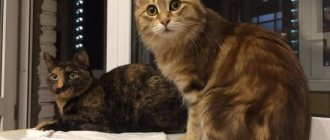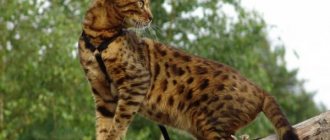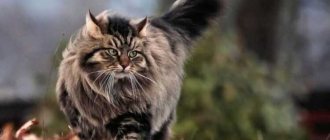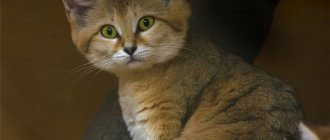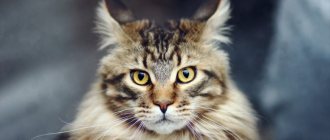In terms of popularity and success, the Siberian cat occupies almost a leading position among other breeds.
Representatives of the species are often credited with Russian roots, although in fact their ancestors were exclusively Asian cats.
And yet, even their foreign origin did not prevent them from winning the respect and title of real Russian heroes, whose goal is to protect housing by any means, to help its inhabitants in everything and to expand their habitat right up to the most extreme borders of not only our state, but to climb beyond its borders.
Breeders, in turn, repeatedly ask questions. For example, is it possible to pay attention to this fluffy beauty if there are children in the house? What are representatives of the Siberian cat breed like? How to properly care for and feed your pet for complete happiness?
It's time to reveal all the ins and outs and dispel existing myths about these charming creatures, leaving room for the truth.
A little history
Until recently, the owners of these fluffies did not wonder about the pedigree of their pets, believing that their ancestors came from the Siberian wilderness. At the end of the last century, when clubs for cat lovers were created, they began to find out the history of the origin of Siberians.
Several versions have emerged about the true ancestors of Siberian cats. Their ancestors could have been cats that lived in the Norwegian forests, which were brought to Siberia, and then they spread throughout the entire territory of our Motherland.
- Another version says that they are descendants of Bukhara cats brought by merchants from Asian countries.
- In 1986, metropolitan breeders began to develop a breed standard.
- To do this, they used animals brought by local residents. They wanted to call the breed “Moscow”.
- Afterwards, cats brought from the Siberian hinterlands and the Far East were used.
Already in 1991, the standard for the Siberian breed in Russia was adopted and approved. Five years later, this standard was adopted by the American felinological organization. Today in our country there are several organizations involved in breeding Siberians.
In addition, there are many felinological clubs in different regions of Russia. Siberian felinologists breed cats based on local representatives of the breed.
Appearance
The Siberian cat breed can be described as follows: they have a truly royal appearance and majestic appearance.
Their thick fur makes them look impressive. The strong, large body harmonizes perfectly with the sweet, majestic face.
Siberians have a proportional body:
- A dense body of medium length, a powerful back and a wide chest combine perfectly with a small neck on which an elegant frill flaunts;
- The head is in the form of a trapezoid, the muzzle has smooth outlines. Developed, low-set cheekbones and dense cheeks;
- The ears are medium in size, wide at the base and rounded at the tips. The earlobe has long fur;
- The eyes are medium-sized, oval-shaped, widely spaced. Eye color can be green or yellow;
- Paws are powerful, muscular, of medium length;
- The tail is wide at the base, narrowed and rounded towards the tip;
- The coat is soft, dense undercoat of fine texture. In summer, Siberians have shorter fur than in winter. By the cold season, they develop a rich, thick collar, and their hind legs become more fluffy;
- The weight of males can reach twelve kilograms, females - seven kilograms;
- Height from 28 to 40 centimeters;
- Life expectancy is from 15 to 20 years.
Breed defects
Despite its long history, the Siberian cat breed has not yet been fully formed. Sometimes genes can develop in such a way that the offspring will have problems with both phenotype and health. If in the first case the defects are regarded as a breed defect and do not at all interfere with the normal life of the cat, then hereditary diseases should be a signal to the breeder that it is advisable not to allow this line of sires into breeding.
Major diseases
The peculiarities of the formation of the breed generally had a positive effect on the health of its representatives. Having gone through a long stage of natural selection in the harsh climatic conditions of Siberia, these cats have learned to perfectly resist many diseases. The famous Siberian health is fully inherent in them, which is one of the undoubted advantages of this breed. If well maintained, a Siberian can live twenty years or even more.
Typically, Siberian cats have good health, but pathologies are possible
Among the hereditary diseases to which these animals are predisposed is hypertrophic cardiomyopathy, a severe but fortunately rare heart disease that usually ends in death.
Siberian cats by nature are textured, powerful animals; A strong, well-formed bone structure is especially important for them. Improper cultivation, regular overeating and lack of sufficient exercise can lead to the development of musculoskeletal problems. Like all heavy individuals, Siberians have risks of dysplasia and other joint diseases, especially in old age.
In recent years, such illnesses have been provoked by unscrupulous breeding work. Some, by hook or by crook, try to get overly large animals that look impressive and are expensive. Unfortunately, few people realize that high-quality cultivation of such giants is not only very difficult and expensive, but is also fraught with many health problems.
Pedigree marriage and disadvantages
A disadvantage of the breed is considered to be a straight profile - ideally, the transition on the muzzle from forehead to nose should be very smooth. The massive rounded head of the Siberian cat is generally the subject of close and meticulous attention of experts who, acting in accordance with the standard, can find a number of disadvantages here:
- too short or, conversely, long lightweight muzzle;
- flat cheeks;
- high cheekbones;
- weak chin;
- small, round or deep-set eyes;
- large or small, incorrectly set or too furry ears.
Breed defects are “written” on the cat’s face
Also a serious drawback can be considered a square or overly stretched body format, its lightness and grace. Elegance and grace - this is definitely not what is said about the Siberian. He walks, leaning heavily on his strong paws, which should not be thin or high. Special requirements apply to the tail: the more luxurious it is, the better. A bald or short, expressionless tail is a definite breed defect and a personal disgrace for a Siberian cat.
Color of Siberians
The color of a Siberian cat can be either uniform or patterned. The standard colors are black, red, striped and smoky.
- Black is characterized by black stripes between which there may be gray, brown or red fur.
- Red. It can be of a red hue and tortoiseshell, that is, black and red.
- Striped. It is distinguished by the presence of stripes on the paws and tail and their complete absence on the body.
- Smoky. The appearance of a grayish tint is given by the white undercoat.
In addition, there are many different colors. For example, tabby, when each hair is colored in a light and dark shade, as a whole, forming a pattern. Tabby comes in three varieties: marbled, brindle and spotted.
Golden cats look great when every hair is apricot-colored. White color is very rare among Siberians, but it looks beautiful. This photo shows a Siberian cat with a smoky color.
Description and breed standard
The description of the Siberian cat breed correlates well with its habits and appearance. Breed characteristics include body size, head size, eye shape, tail and coat description. And so what breed standard does the fluffy beauty have:
- These are quite large animals. Body weight can reach 6–12 kilograms.
- Representatives have some features. Many have a massive neck, strong back, and toned stomach.
- The head is medium or large. This is influenced by the variety.
- The eyes are oval shaped.
- The ears are not big.
- Thick and long coat. Has a double undercoat. There are smooth-haired representatives.
- The tail is long, fluffy, large.
Despite the large amount of wool, the breed is considered hypoallergenic. Good for allergy sufferers.
Different types of Siberian cats have their own unique characteristics, ranging from the color of their fur coat to the presence of tufts on their ears.
Colors
The colors of the Siberian cat can be very diverse:
- The rarest color is white. A solid shade that should be absolutely pure. White representatives are also called Angora. The presence of stains is unacceptable according to the standard. A white cat may have honey, orange and blue eyes.
- Black Siberian. Another name for black marble. Quite a rare combination. Kittens are usually brown at birth, which subsequently darkens. This color easily fades in the sun, becoming a reddish tone. This is unacceptable for show cats.
- Gray Siberian. Representatives of this species are divided into smoky color and marble color.
- Tortoiseshell color. As a rule, these are three-colored pets. Combines red and black tones. The red part should not have any pattern, and the tones should be harmoniously located throughout the pet’s body.
- Black and white cat. Also has two color options. Black smoke covers the entire body of the animal in uniform spots. In the second option, the black marble shade affects only the face, ears, paws, tail and back.
- Smoky color. The shade is uniform, distributed over the entire body of the animal. The color of the coat is blue.
- Siberian color point or masquerade. Pets are born white; they get striped color much later.
- Golden color. Representatives are very beautiful, have red and brown spots.
- The tabby or patterned color is most suitable for the wild ancestor. Often found in Russian courtyards. A short-haired variation of this color is also possible.
Character and habits
The character of the Siberian cat fully corresponds to its name and pedigree. Habits and basic instincts make themselves known at the first convenient opportunity. The cat is a rat catcher and a real hunter. They are not afraid of dogs and bravely guard the territory from uninvited guests.
The animal is very smart, quickly gets used to its name and the place where the toilet is located. The Siberian breed is affectionate with people, but at the same time restrained. You can pet her only with her consent. A strong character does not interfere with getting along with kids.
Animal character
Siberian cats have an easy-going character. They are playful, active and very attached to their owners. But they are not devoid of self-esteem. They may not respond to the owner’s caresses, as they are subject to mood swings.
At the same time, Siberians are very tactful and will not impose themselves if the owner is busy or not in the mood. They are funny and can make you laugh with the way they love to cuddle on your back in different positions. Possessing a strong character, they do not seek to dominate in relationships with animals.
Hardy, unpretentious and courageous, they treat strangers and animals with suspicion, so they are not the first to make contact. Siberians are inquisitive and love space and nature. Therefore, a cat living in a city apartment must be allowed outside at least once a week.
Reviews
I suggest you learn more about the breed and read reviews from the owners of these cats. All comments are taken from the Otzovik website.
Affectionate and angry cats
The author of the first review talks about the inconsistency of the cat's character. On the one hand, the animal is very affectionate, but sometimes it can scratch if something goes wrong. The pet eats only fresh meat and drinks only fresh water. Not afraid of dogs. Very smart and curious - she sticks her nose everywhere.
Phlegmatic cat
The author of the second review says that her cat is absolutely fearless. He is not afraid of water or neighbor's animals, and the small family dog has become his best friend. On the other hand, the Siberian does not show hunting skills and can suffer from the tenacious claws of other animals. The cat takes bathing and nail trimming well. Although he lives in a private house, he does not like to walk on the street.
Lady with character
The author of the third review says that her cat is a good hunter. Loves to play and indulge. The pet lives by the rules of the house and knows its place to relieve itself. Friendliness is manifested by her mood - the Siberian is willful, and if she does not want to communicate, then you will not keep her. Gets along well with other animals.
Proper care
Due to the fact that representatives of this breed are very neat and clean, they do not require special care. They quickly get used to the tray. The only thing furry pets need is brushing.
You need to brush your Siberian once a week, and more often when your pet sheds. To do this you will need a comb for thick hair. Brushing stimulates blood circulation and removes unwanted hair and skin flakes.
But you should not wash your pet often. The exception is trips to nature.
- You can bathe the animal in a large basin or bathtub. Place a rubber mat on the bottom of the container.
- You can cover your pet's ears with cotton wool.
- Using a sponge, wet the fur and gently rub in the shampoo.
- After which, the shampoo must be rinsed off and the pet should be wrapped in a soft towel.
- The water temperature for swimming should not exceed 39 °C.
There should be no drafts in the room where the cat will dry out after water treatments. For washing, you can use dry powders, which, after applying to the wool, need to be combed out with a brush. You should clean your pet's ears and eyes regularly.
Diet of the Siberian cat
Siberians are not picky when it comes to nutrition. They have an excellent appetite, but they should not be overfed. Representatives of the Siberian breed prefer raw foods. They love seafood, especially shrimp.
- Lean meat, fish, egg yolk, offal, and dairy products are good for them.
- Meat can be given to your pet raw, and fish only boiled.
- Eggs and dairy products must be given at least once a week.
- Pregnant cats and kittens benefit from low-fat cream and goat's milk.
It is best to accustom your pet to various cereals. As additional nutrition and treats, it is sometimes necessary to give dry food, but of good quality. Dry food contains essential vitamins and is an excellent way to clean your cat's teeth.
Health
Despite their strong, excellent health, these fluffies are susceptible to disease. Most often, among representatives of this breed there are diseases of the digestive system, heart and blood vessels, kidney failure and allergies.
- Siberians can have allergic reactions to household dust, pollen, and even food.
- Digestive and heart problems are caused by a pet's sedentary lifestyle and poor diet or overeating.
- Symptoms of heart disease include cough and shortness of breath. Siberians are susceptible to periodontal disease.
There is an inheritance of cancer among Siberian cats. This phenomenon mainly occurs in representatives with white fur.
Diseases of the genitourinary system, which can cause kidney failure, are dangerous for Siberians. It happens that a cat accumulates a large amount of hair in its body, some of which it regurgitates. If such problems arise, you need to give the cat a tablespoon of vegetable oil; a teaspoon of oil will be enough for the kitten.
Kitten weight by month
In a litter of Syrians there can be up to 9 cubs, reproductive age lasts up to 18 years.
- A Siberian kitten is born weighing approximately 100 grams.
- At 2 months, a kitten should weigh 2-3 kilograms.
- At 5-6 months, Siberians can reach 4-6 kg.
- By the age of one year, a kitten’s weight can reach 5-7 kg, the same as an adult’s weight. Cats can weigh up to 12 kg.
The size and weight of Siberian little kittens always exceeds the dimensions of an ordinary cat. Weight largely depends on the diet of the animal. All babies are individuals and develop at their own pace.
How long do Siberian cats live?
Many factors influence the lifespan of pets. The first is heredity. Since the ancestor of Siberians was the Bukhara cat breed, they received strong immunity, plus, as a result of natural selection in harsh conditions, Siberians acquired additional endurance and resistance to disease.
On average, a Siberian cat lives 15-17 years, but long-livers are often found; they bring joy to their owner for more than 20 years.
The main thing is to seek help from a specialist in a timely manner, and not to treat your pet on your own and monitor its behavior. If a previously active cat suddenly refuses to play or eat, this is an alarming sign; do not delay visiting the veterinary clinic.
Choosing a kitten
In order to take a little Siberian into your home, it is better to contact breeders who have proven themselves to be excellent. Since unscrupulous sellers can sell outbred animals, taking advantage of the fact that Siberian cats have a variety of colors.
- The best age to adopt a Siberian cat kitten into your home is three to four months.
- At this age, it is possible to raise a child as needed.
- A six-month-old kitten will have to be retrained, since it has already formed certain habits.
- A three-month-old fluffy should be moderately well-fed and show interest in the world around him. He should not try to escape if picked up.
The baby should have a wide chest, strong paws and shiny fur. The seller is obliged to provide information about vaccinations and pedigree. If the kitten does not have documents, then its price will be no more than three thousand rubles.
A Siberian cat with a pedigree can cost from ten to thirty-five thousand rubles. This price range is explained by the rarity of the animal’s color.
Price
Due to the fact that Russia is considered the birthplace of the Siberian cat, prices for purebred kittens are relatively low. There are many nurseries, so you can choose a pet to suit your taste. If the animal is to be bred, you will have to pay a little more money for it than for a pet without documents and pedigree. Cats purchased for participation in exhibitions are even more expensive. So, a kitten without documents can be adopted for 30-50 dollars. A kitten with minor shortcomings of the breed will cost more - $100-200. Kittens for breeding and exhibitions are sold at a higher price. Their cost is about 300-500 dollars.
Before purchasing, it is important to know what the breed's disadvantages are. Among them: graceful (fragile) physique, flat cheeks, soft chin, narrow and round eyes, tail length inappropriate for the breed (short or long), lack of undercoat or, conversely, its abundance. Pay attention to this and be careful if you decide to purchase a pet without documents.
Interesting Facts
Siberians' favorite place to stay in the house is closets and other high places. This is explained by their innate hunting instinct. Climb higher and observe the world around you.
- Siberians perfectly grasp intonation and are able to remember various commands.
- They can even be taught to fetch objects, but due to their natural stubbornness, they will not do it at the first call.
- Therefore, during the learning process they must be encouraged and in no case scolded.
- Representatives of the breed with color point color were identified as a separate breed and called “Neva Masquerade”.
- The warm coat of a Siberian cat not only prevents it from freezing in the cold, but also protects it from rain.
Some representatives of the Siberian breed can be adopted by people who are allergic to cat fur.
Colors
Experts count more than two hundred different types of colors of Siberian cats. Some rare varieties are not generally recognized. There are several exceptional colors that allow their owners to stand out in a separate category. The most common types of kitten colors are:
Solid
Solid colors are divided into two main categories - black and red (fawn). Lightening a black shade gives a bluish-gray solid blue color, and lightening a red shade gives a creamy solid cream color. Cat fur must be reliably protected from direct sunlight, which leads to fading (loss of rich tone). The color of the nose, heels and eyes most often matches the color of the skin, but this is not always the case.
Tortoiseshell (tortie)
The combination of red and black or lightened shades (blue and cream) gives a tortoiseshell color, which is characterized by a uniform arrangement of color spots on the surface of the body. This coloring is more typical for cats, but there are also males with a tortie color. A red spot on the forehead is a sign of belonging to the elite.
Tabby
The coloring in the form of dark spots and lines on different parts of the body is due to the presence of the agouti gene in the animal’s genetic material. Depending on the shape and location of the marks, there are three main types of this color:
- The marble coloring is characterized by “necklaces” on the chest and neck, wide stripes along the spine, rings on the tail and characteristic “butterfly wings” on the lateral surfaces of the body.
- The alternation of dark and light stripes is called brindle (striped).
- Numerous dark spots in the form of “rosettes”, like those of a leopard, correspond to the spotted color.
All types of tabbie colors are found in shades of red, black, cream, blue.
Smoky
If the color is present only on the upper part of the hairs, at first glance this color is perceived as monochrome with a slight “haze” tint. Found in a wide variety of color variations.
Gold
Golden colors are classified as follows:
- Golden tabbies have hair that is more than half gold.
- Shaded gold is a shade in which more than two-thirds of the hair is covered in apricot tone.
- Each chinchilla hair is colored 7/8 parts in a sunny tone.
Grayish shades are not allowed. True golden cats should only have green eyes.
White
Rare and valuable color. There are true albinos, or carriers of the Siamese shade with a colorless mask on the muzzle.
Bicolor
Bicolor cats must have white spots on their skin. A separate group includes the colors harlequin (the area of white spots is less than 1/6 of the total surface of the skin) and van (almost white, with small colored spots near the ears).
Color point
These cats are recognized as a separate breed (Neva Masquerade) due to the dark coloring of the face and limbs on a light background.
Point
Owners of a dark nose, paw pads and a black and brown mask. Other shades can be in red, black, blue or cream.
Tabby point
The mask on the face is complemented by markings in the form of stripes on the paws and tail. The forehead is crowned with a characteristic mark in the form of the letter “M”.
Pets of any color are the unique fruit of many years of work by breeders who strive to consolidate the classic norms of cat beauty in the breed.
